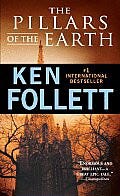Ken Follett was a successful author of thrillers for many years before publishing Pillars of the Earth, his first work of historical fiction. His agent had previously discouraged him from writing a historical novel, telling him historicals did not usually sell well. In fact, Pillars of the Earth sold more copies than any of Follett's previous books, several of which were bestsellers, and once in paperback continued to sell well. Its success may be due at least partly to the experience he developed writing suspense: this long and sprawling novel, full of period detail, is also a page-turner written in a popular rather than a literary style.
Set in twelfth-century England, the story begins with the theft of a pig which sends a family spiraling into ruin. The central character, a kind and persistently optimistic man, has the good luck and determination to work his way out of disaster. He is a builder, and his story revolves around the building of a cathedral in the fictional town of Kingsbridge. A central theme is the conflict between church and state, portrayed at a different social level than the struggles between kings and popes that historical fiction often featured before Follett broke the mold. (1989, 973 pages)




